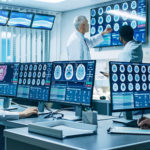By Nathalie Boudet-Gizardin, Partner and Mathilde Jannet, Lawyer
New installation and operating conditions
While the National Academy of Medicine called on June 27 for a replacement of the current procedure for the authorization of heavy material equipment by an authorization for imaging care activities[1], like those of neurological, cardiac interventional radiology and nuclear medicine, this is another option that was taken by the two decrees n°2022-1237 and n°2022-1238 of September 16, 2022.
Only the activity of interventional radiology has been elevated to the rank of care activities subject to prior authorization from the Regional Health Agency (ARS), and cross-sectional imaging for diagnostic radiology purposes therefore escapes the regime of activities of care.
The new regulations, which will come into force on 1er June 2023, however, are changing the conditions for setting up and operating EMLs dedicated to diagnostic radiology.
Which EMLs are involved?
The new article R. 6122-26 of the Public Health Code now makes a distinction within cross-sectional imaging EMLs used for performing diagnostic procedures between:
- on the one hand the nuclear magnetic resonance imaging apparatus for medical use (MRI)
- and on the other hand the scanners for medical use " (to scan).
Only these two types of equipment will be subject to prior authorization from the ARS, excluding cross-sectional imaging EMLs used for activities subject to specific authorizations (nuclear medicine activity, interventional activity under medical imaging in cardiology or neuroradiology, interventional radiology activity).
What are the conditions for setting up these EMLs?
- Permission to use cross-sectional imagery EMLs will now be given in the form of a single authorization per geographical site, and no longer one authorization per EML type. The race for permissions is over!
- The maximum number of devices that can be operated by the same holder on the same geographical site has been set at only three), unless expressly waived by the director of the ARS if the territorial situation, the volume of acts, their nature, or the specialization of the activity justify it, but within the limit of eighteen equipment[2].
- If the holder of an authorization only has an MRI or a scanner on the geographical site concerned, the latter must in principle establish an agreement with another authorization holder having the missing type of equipment. However, if he holds an authorization for the missing equipment on another geographical site, he will then only have to formalize an internal organization guaranteeing patient access to the other type of equipment.
- The holder of an authorization having at least three pieces of equipment on the same geographical site must have cumulatively at least one MRI and one scanner among these equipments.
What procedure should be followed when installing or replacing these EMLs?
The procedure provided for by the new article R. 6122-39-1 will be simplified in the event of installation or renewal of a cross-sectional imaging EML:
If installing a new Slice Imaging EML:
- If this does not lead to the overrun of three equipment, the holder must inform the ARS of the characteristics of the equipment installed before it is put into service.
- If this leads to exceeding the threshold of three devices, the installation will be subject to the modification of the initial authorization.
If replacing a slice imaging EML:
- By an EML of the same nature, regardless of the number of authorized pieces of equipment available to the holder, the latter must inform the ARS of the characteristics of the replaced equipment before it is put into service,
- By an EML of a different nature, the holder must make a request for modification of the authorization under the conditions of article D. 6122-38, II of the CSP when he has more than three pieces of equipment. On the other hand, the text is silent on the procedure to be followed in the event of replacement of a cross-sectional imagery EML, by an EML of a different nature, when its holder has a maximum of three pieces of equipment.
What are the operating conditions of these EMLs?
Decree n° 2022-1237 of September 16, 2022 in particular provides details concerning the radiological teams made up of:
- One or more doctors specializing in radiology and medical imaging, who provide on-site radiological care;
- One or more medical electroradiology manipulators, present on site during the management of the patient's radiological care.
- The license holder also secures the assistance of a medical physicist as part of the process of optimizing exposure to ionizing radiation.
It is also specified that the holder of a cross-sectional imaging authorization may not carry out his radiology activity mainly by tele-radiology, with the exception of radiological care carried out as part of on-call care or if the general manager of the ARS temporarily authorizes, when the situation justifies it, the holder to carry out remote diagnostic procedures.
Several requirements relating to the accessibility of cross-sectional imagery EMLs by license holders, to the premises in which they are located, to the obligation of quality assurance, to the obligation to collect and analyze data from professional practices, regular updating of recommendations for good radiological and medical imaging practices to be applied, connection of cross-sectional imaging EMLs to an examination archiving, sharing and distribution system , are recalled by the decree n° 2022-1237 of September 16, 2022.
What participation in ongoing care is required?
- The director of the ARS may, depending on the specific needs of the area concerned, offer the holder of an authorization to participate in ongoing care, having recourse if necessary to means of tele-radiology. This permanence of care may be common to several authorized sites.
- The director of the ARS may require the holder of an authorization having at least three cross-sectional EML images on the same geographical site, the guarantee to carry out examinations and to interpret the results on at least one MRI , for urgent and unscheduled care over periods of twelve hours on working days.
What future for EML authorizations already issued and/or in progress on 1er June 2023?
Although the aim of this reform is to allow a better territorial distribution of the diagnostic radiology care offer in the interest of patients, it gives rise, for the holders of cross-sectional imaging EML licenses, to uncertainties relating to the maintaining their current authorizations.
Decree n° 2022-1237 of September 16, 2022, provides, in its article 2, that the holders of EML authorizations for cross-sectional imaging, issued before 1er June 2023, and in progress during the first filing period opened after 1er June 2023, will have to file, as part of this, a new request for authorization for the exploitation of these cross-sectional imagery EMLs.
However, this request will be the subject of a specific file according to the procedures set by order of the Minister of Health, which is yet to be published, and is obviously eagerly awaited.
However, applicants may continue to use their cross-sectional EML authorizations until a decision is made on their new application.
The decree also specifies that the ARS will have until 1er November 2023 to update the regional health plans taking into account these new provisions.
As an exception to the new provisions, the holder of an authorization who has reached or exceeded the threshold of three pieces of equipment per geographical site and who does not have at least one MRI and one scanner may be issued a new authorization provided that comply with this regulation in the event of the installation of additional equipment or the replacement of existing equipment.
Unlike the reform on nuclear medicine which has plunged professionals into real instability with regard to their methods of exercise, this reform relating to the conditions for the implantation and operation of cross-sectional imaging EMLs promises to be less destabilizing for current holders of EML authorisations, although the system remains to be completed.
[1] " Radiology, the financialization of all dangers: preventing risks for radiologists and patients », Press release from the National Academy of Medicine, June 27, 2022
[2] Articles 1 and 2 of the decree of September 16, 2022 setting, for an authorized site, the number of cross-sectional imaging equipment pursuant to II of article R. 6123-161 of the health code public

Nathalie Boudet-Gizardin
Partner
Expert in health law and regulated professions (advice and litigation), she works in various fields: structuring the activity of health professionals, advice on the regulatory and ethical aspects of their activity, defense of health actors in complex litigation, corporate health, civil and disciplinary litigation of regulated professions.





